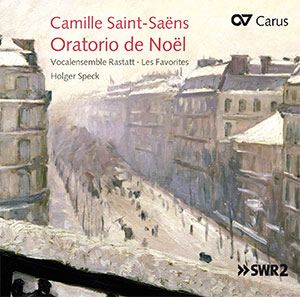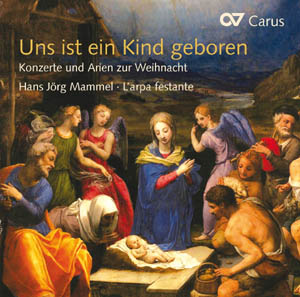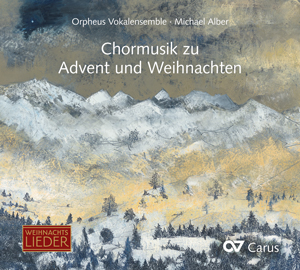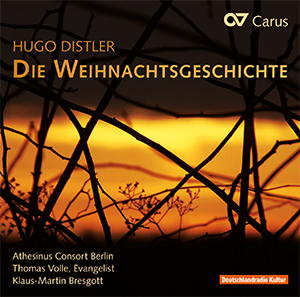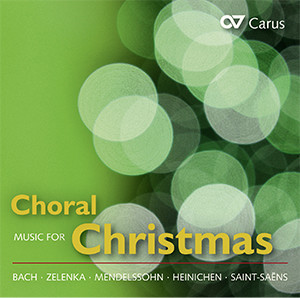
Choral Music for Christmas
“Choral Music for Christmas” presents the very best of Advent and Christmas choral music from the Carus catalog. Contemporary arrangements of popular Christmas carols by composers such as Fredo Jung and Giacomo Mezallira feature alongside works by well-known composers including Handel, Bach, Heinichen, and Mendelssohn Bartholdy. The performers, including the Calmus Ensemble, the Kammerchor Stuttgart conducted by Frieder Bernius, the Dresdner Kammerchor conducted by Hans-Christoph Rademann, and the ensemble L’arpa festante, guarantee an absolute choral treat.
Acheter
Informations complémentaires sur l'œuvre
Sommaire
-
Chœur
Kammerchor Stuttgart
The Kammerchor Stuttgart is regarded as one of the best ensembles of its kind. Over its fifty-year existence, Frieder Bernius has developed the choir into an exceptional ensemble acclaimed by audiences and press alike. This has led to invitations for the choir to perform at all the important European festivals. In Germany the chamber choir performs at festivals and in concert halls in repertoire ranging from the 17th to the 21st century. Frieder Bernius and his ensemble have received numerous accolades for their contribution to new music. The Kammerchor Stuttgart has made over 80 CDs and LPs, numerous of which have been awarded international recording prizes (including the Edison award, Diapason d’or, Gramophone Choice, Classical Internet Award, International Classical Music Award, and German Record Critics’ Award prizes). The International Federation for Choral Music has invited the ensemble to sing at the 1st, 4th and 10th World Symposia on Choral Music in Vienna, Sydney and Seoul. Regular tours of North America and Asia since 1988 and a South America tour reflect the Kammerchor Stuttgart’s international reputation. Since 1984 the top ensemble has also been invited to Israel biennially. Plus d'information sur la personne
-
Chœur
Dresdner Kammerchor
Le Dresdner Kammerchor (Chœur de chambre de Dresde) – l’un des meilleurs chœurs d’Allemagne – est bien connu pour sa sonorité unique, faite d’une grande intensité et clarté. Rayonnement dynamique, homogénéité et transparence sonores souvent cités en exemple sont les points forts de cet ensemble demandé au niveau international. Le chœur a été créé en 1985 par Hans-Christoph Rademann et des étudiants du Conservatoire de musique « Carl Maria von Weber » de Dresde. De nombreuses tournées de concerts ont établi la notoriété de l’ensemble également hors d’Europe. En ont résulté des invitations régulières à d’importants festivals internationaux. Le répertoire du chœur va de la musique de la Renaissance à des compositions du 21ème siècle. Des interprétations de la musique chorale romantique et contemporaine ont été récompensées de prix spéciaux lors de concours internationaux, ainsi que du prix d’encouragement de la fondation Ernst von Siemens. En dehors de la pratique a cappella, le chœur de chambre se consacre intensément à la coopération avec le Dresdner Barockorchester et l’ensemble « Alte Musik Dresden », donnant des impulsions importantes à la pratique de la musique ancienne en Saxe. Une foule d’enregistrements pour la radio et pour le CD, ainsi que la coopération avec des orchestres allemands et étrangers viennent renforcer la renommée du Chœur de chambre de Dresde. Le CD paru aux Editions Carus de Stuttgart, avec le premier enregistrement mondial du Requiem en mi bémol majeur de Johann Adolf Hasse s’est vu décerner le prix de la Critique allemand du disque. Plus d'information sur la personne
-
Chœur
Vocalensemble Rastatt
Alongside its dedication to a core repertoire of composers such as Monteverdi, Schütz, Bach, Mozart, Haydn, Schumann, and Brahms, the Vocalensemble Rastatt & Les Favorites frequently explore new terrain with premiere performances. On the heels of its successes in national and international choir competitions, the ensemble has taken part in numerous internationally acclaimed CD recordings as well as radio, and television productions for SWR, Radio France, Deutschlandradio Kultur, and Deutschlandfunk. The Vocalensemble Rastatt & Les Favorites have performed in the Festspielhaus Baden-Baden, the Musikfest Bremen, the Kölner Philharmonie, the SWR RheinVokal Festival, the Europäisches Musikfest Stuttgart, the Schwetzinger Festspiele, the Deutschlandradio Kultur Wartburgkonzerte, the Internationale Musiktage im Dom zu Speyer, the Philharmonie in Mulhouse, and the Centre de Musique “Les Dominicains” in Guebwiller, France, among other venues. The flexible choir does not shy away from excursions into the world of opera, having performed Donizetti’s Lucia di Lammermoor and Bellini’s Norma with Edita Gruberova, and Mozart’s Don Giovanni and Così fan tutte with Rolando Villazón. Together with Klaus Maria Brandauer and the Chamber Orchestra of Europe, the choir also performed Mendelssohn’s Sommernachtstraum at the Musikfest Bremen. The ensemble is sponsored by the German state of Baden-Württemberg in co-operation with its “Kunst 2020” program, as well as by its home city of Rastatt. Plus d'information sur la personne
-
Chœur
Vocal Concert Dresden
Le Vocal Concert Dresden, créé par Peter Kopp en 1993 sous le nom de « Körnerscher Sing-Verein », est constitué pour l’essentiel de diplômés du Conservatoire de musique de Dresde et d’anciens membres du Dresdner Kreuzchor (Chœur de la Croix de Dresde). Le répertoire exigeant du chœur de chambre propose des programmes avec des œuvres de Schütz, Bach, Händel, Haydn, Mendelssohn ou Brahms jusqu’à des compositions contemporaines, en partie des créations. L’intelligence d’interprétation du Vocal Concert Dresden, mais plus encore le rayonnement émotionnel de ses concerts ont contribué à sa réputation d’ensemble d’exception et à sa reconnaissance. L’ensemble se voit toujours plus attester goût stylistique sûr et pratique musicale élégante et naturelle. Le chœur s’est produit à plusieurs reprises dans des concerts de la Sächsische Staatskapelle Dresden et de la Philharmonie de Dresde. Il a été e. a. l’hôte de la Semaine Bach d’Ansbach, du Festival Händel de Göttingen, du Festival du château de Potsdam, du Festival Händel de Halle, du Festival de Ravello (Italie), il a été reçu en Pologne, en Hollande et plusieurs fois aux États-Unis. La musique de la fin du 18ème siècle, pour laquelle le Vocal Concert Dresden a développé une sensibilité particulière, est au cour de son intérêt. Plus d'information sur la personne
-
Ensemble
Les Favorites
Alongside its dedication to a core repertoire of composers such as Monteverdi, Schütz, Bach, Mozart, Haydn, Schumann, and Brahms, the Vocalensemble Rastatt & Les Favorites frequently explore new terrain with premiere performances. On the heels of its successes in national and international choir competitions, the ensemble has taken part in numerous internationally acclaimed CD recordings as well as radio, and television productions for SWR, Radio France, Deutschlandradio Kultur, and Deutschlandfunk. The Vocalensemble Rastatt & Les Favorites have performed in the Festspielhaus Baden-Baden, the Musikfest Bremen, the Kölner Philharmonie, the SWR RheinVokal Festival, the Europäisches Musikfest Stuttgart, the Schwetzinger Festspiele, the Deutschlandradio Kultur Wartburgkonzerte, the Internationale Musiktage im Dom zu Speyer, the Philharmonie in Mulhouse, and the Centre de Musique “Les Dominicains” in Guebwiller, France, among other venues. The flexible choir does not shy away from excursions into the world of opera, having performed Donizetti’s Lucia di Lammermoor and Bellini’s Norma with Edita Gruberova, and Mozart’s Don Giovanni and Così fan tutte with Rolando Villazón. Together with Klaus Maria Brandauer and the Chamber Orchestra of Europe, the choir also performed Mendelssohn’s Sommernachtstraum at the Musikfest Bremen. The ensemble is sponsored by the German state of Baden-Württemberg in co-operation with its “Kunst 2020” program, as well as by its home city of Rastatt. Plus d'information sur la personne
-
Ensemble
Dresdner Instrumental-Concert
Le Dresdner Instrumental-Concert réunit depuis 1995 des artistes jouant sur des dénommés instruments historiques avec le souci d’authenticité des styles. Son nom puise son origine dans la vie musicale bourgeoise de Dresde vers 1800. De nombreux concerts et enregistrements – notamment en coopération avec le Vocal Concert Dresden sous la direction de Peter Kopp – sont autant de brillantes manifestations de sa qualité artistique. Le répertoire se consacre pour l’essentiel aux trésors de l’histoire musicale de Dresde et de sa tradition. Les critiques de la presse internationale et les réactions du public ne cessent de mettre en valeur la sonorité sensuelle et le jeu raffiné du Dresdner Instrumental-Concert. Plus d'information sur la personne
-
Ensemble
L'arpa festante Barockorchester
-
Ensemble
Orpheus Vokalensemble
L'Orpheus Vokalensemble a été créé en 2005 comme chœur de chambre professionnel de l'Académie musicale du land de Bade-Wurtemberg. Il est de distribution internationale et exige les plus hautes compétences vocales de la part de ses membres. Des chefs de chœur de renommée internationale sont invités pour les phrases de travail. Ils marquent durablement de leur empreinte la qualité artistique de l'ensemble. Le modèle est ici le légendaire Orpheus Chamber Orchestra (New York), qui a donné son nom à l'ensemble. Le but du travail artistique est, lors de l'étude et de la représentation d'œuvres musicales, de reporter les principes de la musique de chambre – engagement personnel et respect mutuel – sur le travail d'ensemble avec des voix. De plus, les membres ont un droit de décision dans le choix du répertoire, des solistes et des chefs ainsi que des programmes de concert. Plusieurs compositeurs ont déjà écrit des œuvres pour l'Orpheus Vokalensemble, parmi eux Bo Hansson, Knut Nystedt, Gregor Hübner et Jürgen Essl. En 2006, l'ensemble a été invité à participer au Festival international du lac de Constance. D'autres invitations à des festivals célèbres ont été faites. Plus d'information sur la personne
-
Ensemble
Calmus Ensemble
Homogenität, Präzision, Leichtigkeit und Witz – das sind die Markenzeichen von Calmus, heutzutage eine der erfolgreichsten Vokalgruppen Deutschlands. Das Ensemble besitzt eine Klangkultur, wie sie nur von wenigen erreicht wird. Die breite Palette an Klangfarben, die Musizierfreude, die die Musiker auf der Bühne vermitteln, aber auch ihre abwechslungs- und einfallsreichen Programme werden von der Presse immer wieder hervorgehoben. Die fünf Leipziger haben eine ganze Reihe internationaler Preise und Wettbewerbe gewonnen, u.a. den ECHO Klassik und den Supersonic Award, und der Radius ihrer Aktivitäten wird ständig größer und führt sie durch ganz Europa sowie Nord- und Südamerika. 2010 gab das Quintett sein Debüt in der New Yorker Carnegie Hall.
Unermüdlich sind die Musiker bestrebt, neues Repertoire zu entdecken. Geprägt von der vielhundertjährigen Tradition großer deutscher Knabenchöre sind sie natürlich in der Vokalmusik der Renaissance, des Barock und der Romantik zu Hause. Musik unserer Zeit ist ihnen aber ebenfalls ein echtes Anliegen. In allen Sparten gibt es immer wieder interessante Partnerschaften mit Kollegen wie der Lautten Compagney Berlin, dem Raschèr Saxophone Quartet, der Hamburger Ratsmusik oder der Bigband des Hessischen Rundfunks. Da diese im Bereich der zeitgenössischen Musik häufig völlig neues Repertoire bedeuten, hat Calmus über die Jahre zahlreiche Kompositionsaufträge u. a. an Bernd Franke, Steffen Schleiermacher, Wolfram Buchenberg, Mathew Rosenblum, Bill Dobbins, Michael Denhoff und Harald Banter vergeben und Uraufführungen gesungen. Dass sie gerne Pop, Folk und Jazz sowie Chansons und Evergreens der zwanziger Jahre singen, das versteht sich von selbst!
Ein Teil ihrer Zeit ist der Nachwuchsförderung gewidmet, denn Unterricht und Workshops gehören zu ihrem Alltag, zu Hause in Leipzig und unterwegs. Kein Wunder, dass Calmus mit der einzigartigen Besetzung aus Sopranistin, Countertenor, Tenor, Bariton und Bass überall auf der Welt immer mehr Fans hat. Plus d'information sur la personne
-
Ensemble
Athesinus Consort Berlin
The Athesinus Consort Berlin, named after the composer Leonhard Lechner Athesinus (ca. 1553–1606), was founded by Klaus-Martin Bresgott in 1992. He has been the conductor of the ensemble since then. The ensemble, which usually performs as a double quartet and – when enlarged – as a soloistic chamber choir, rehearses and performs both a cappella and continuo literature of the late Renaissance and Baroque as well as modern and contemporary works, which regularly result in world premieres. The ensemble members, all experienced concert singers who are also active in the Collegium Vocale Gent, the Chor des Bayerischen Rundfunks, the SWR Vokalensemble and the RIAS-Kammerchor, as well as on the stage of the Deutsches Theater Berlin, with Sasha Waltz & Guests and others, are united in their delight sounding out the verbal images of speech and suggestive arts. All of the ensemble members are active as soloists in addition to their activities in larger ensembles. The spectrum here ranges from Johann Sebastian Bach’s oratorios to experimental music of the 21st century. The latest successes of the ensemble include, among others, the world premiere of the music theatre piece Paulus. Das ängstliche Harren der Kreatur by Thomas Jennefelt in 2011, the world premiere of the tryptich Du bist mein Schlaf by Frank Schwemmer in 2012, the world premiere of Drei Gedichte von Rainer Maria Rilke by Jonathan Brell (*1987) in 2013, as well as the world premiere of Turbulent Days – fünf Spruchmotetten nach Martin Luther King und Martin Luther für 8–12-stimmiges Vokalensemble, Saxophon und Schlagwerk by Frank Schwemmer and Anyone can let you down – no one will let you down by Thomas Jennefelt in 2014. In addition to specific compositional focuses, the Athesinus Consort Berlin has committed itself to selected topics in which the texts are of definitive significance. One emphasis is on the innumerable forgotten strophes of the cornucopia of German folk song. Classical concert principles recede into the background and make way for a more individual form of expression. Exemplary thereof are the collaborations with songwriters, jazz musicians, drummers and percussionists as well as dancers and pantomimes. Since 2010 the Athesinus Consort Berlin has regularly released CDs, including O Heiland, reiß die Himmel auf … vergessene Strophen der Weihnacht (2010), Signale ( 2011) w ith w orks by Michael Praetorius and Thomas Jennefelt or Boten ( 2012) w ith w orks b y J ohann A dam Hiller, Max Bruch, Hugo Distler and others. In 2013 Leonhard Lechner: Mein süße Freud auf Erden. Sacred Choral Music was released (Carus 83.384; a tribute from the ensemble to the man who gave it its name – the works on this CD are also available complete as a music edition, Carus 4.022), followed by Frank Schwemmer: Perlmuttfalter. Contemporary Choral Music (Carus 83.464) in 2014. Plus d'information sur la personne
-
Orchestre
Dresdner Barockorchester
Le Dresdner Barockorchester [Orchestre baroque de Dresde] a été créé en 1991 par des diplômés du Conservatoire de musique de Dresde. Au cours des années, les musiciens saxons ont révélé tout ce qu’il avaient de particulier à apporter à la scène de la musique ancienne : force émotionnelle et expressive, alliée à une musicalité éloquente, une interprétation sous un angle neuf, vivant. Les compositions de maîtres de chapelle et instrumentistes de la Chapelle de la cour de Dresde des 17ème et 18ème siècles comme Hasse, Heinichen, Zelenka, Quantz, Pisendel e. a. constituent un aspect important du répertoire du Dresdner Barockorchester. Le centre de gravité et le défi véritable pour l’ensemble est le vécu direct du concert. Plusieurs enregistrements pour le CD documentent autant l’art des interprètes que la pratique musicale éprise de magnificence de la cour baroque de Dresde. Des tournées ont conduit le Dresdner Barockorchester non seulement dans de nombreux centres musicaux d’Allemagne, mais aussi en Hollande, en Espagne, en Autriche et au Japon. Plus d'information sur la personne
-
Orchestre
Barockorchester Stuttgart
The Barockorchester Stuttgart, which was founded by Bernius in 1985, specializes in 18th century music. The musicians are among the leading representatives of historical performance practice and perform exclusively on original instruments. The ensemble dedicates itself to a large extent to the revival of 18th century operas. It has performed at numerous international festivals, among others in Rome, Dresden and Göttingen. Plus d'information sur la personne
-
Chef d'orchestre
Frieder Bernius
| 1947Frieder Bernius’s work has earned great worldwide recognition. He is in demand internationally as a conductor and as a teacher. His principal artistic collaborators are the ensembles he founded himself, the Kammerchor Stuttgart, the Barockorchester Stuttgart, the Hofkapelle Stuttgart and the Klassische Philharmonie Stuttgart. As a guest conductor, he has collaborated repeatedly with, for example, the SWR Vokalensemble Stuttgart, the Deutsche Kammerphilharmonie Bremen, the Stuttgarter Kammerorchester and the Streicherakademie Bozen. Great stylistic versatility is Frieder Bernius’s hallmark. Whether he conducts vocal works by Monteverdi, Bach, Händel, Mozart, Beethoven, Fauré and Ligeti, stage music by Mendelssohn or symphonies by Haydn, Burgmüller and Schubert, his work always aims for a sound that is at once unmistakably personal and at the same time oriented towards the original period sound ideal. He devotes himself equally to the rediscovery of 18th century operas and to first performances of contemporary compositions. He is particularly interested in the musical history of southwestern Germany. Carus-Verlag has awarded Frieder Bernius a Golden CD for his complete recording of the sacred music of Felix Mendelssohn Bartholdy. The award was presented to him during the German Choir Festival in Stuttgart 2016. The sale of over 250,000 recordings, which has been acclaimed with a number of awards, has made a not insignificant contribution to what today is the obvious presence of Mendelssohn's complete œuvre in the concert repertoire. Plus d'information sur la personne
-
Chef d'orchestre
Hans-Christoph Rademann
| 1965Conductor Hans-Christoph Rademann is an immensely versatile artist with a broad repertoire who devotes himself with equal passion and expertise both to the performance and rediscovery of early music and to the first performances and cultivation of Contemporary Music. Born in Dresden and raised in the Erzgebirge mountains, he was influenced at an early age by the great Central German kantorial and musical tradition. He was a student at the traditional Kreuzgymnasium, a member of the famous Kreuzchor, and studied choral and orchestral conducting at the Carl Maria von Weber University of Music in Dresden. During his studies, he founded the Dresdner Kammerchor and formed it into a top international choir which is still under his direction today. Since 2013, Hans-Christoph Rademann has been the academy director of the International Bach Academy Stuttgart. He regularly collaborates with leading choirs and ensembles of the international music scene. From 1999 to 2004 he was chief conductor of the NDR Choir and from 2007 to 2015 chief conductor of the RIAS Chamber Choir. Guest conducting engagements have led and continue to lead him to the Nederlandse Bachvereniging, the Collegium Vocale Gent, the Akademie für Alte Musik, the Freiburger Barockorchester, the Deutsche Radiophilharmonie Saarbrücken Kaiserslautern, the Sinfonieorchester Basel, the Orchestre Philharmonique de Luxembourg, among others. Hans-Christoph Rademann has been awarded prizes and honors for his artistic work, including the Johann Walter Plaque of the Saxon Music Council (2014), the Saxon Constitutional Medal (2008), the Sponsorship Prize as well as the Art Prize of the state capital Dresden (1994 and 2014 respectively). He received the Preis der Deutschen Schallplattenkritik several times for his numerous CD recordings (most recently in 2016), as well as the Grand Prix du Disque (2002), the Diapason d’Or (2006 & 2011), the CHOC de l’année 2011 and the Best Baroque Vocal Award 2014. In 2016 he was awarded the European Church Music Prize of the city of Schwäbisch Gmünd. His exemplary interpretation and recording of the complete works of Heinrich Schütz with the Dresdner Kammerchor in the Stuttgart Carus-Verlag, which was completed in 2019, was awarded the newly endowed Heinrich Schütz Prize as well as the OPUS KLASSIK 2020 in the same year. Hans-Christoph Rademann is professor of choral conducting at the Carl Maria von Weber University of Music in Dresden. He is also artistic director of the Musikfest Erzgebirge, ambassador of the Erzgebirge and patron of the Christian Hospice Service Dresden. Plus d'information sur la personne
-
Chef d'orchestre
Holger Speck
Holger Speck is founder and artistic director of the Vocalensemble Rastatt & Les Favorites. He has developed a distinguished international reputation as a charismatic musician who is capable of bringing to life the aesthetic details of the sound particular to different periods, while communicating emotive content to the listener. His keen sense of sound assures the unmistakable tonal quality of his ensembles. His compelling, lively, and profound interpretations are regularly praised in specialist publications. He has conducted at famous festivals and concert halls such as the Festspielhaus Baden-Baden, the Philharmonie Mulhouse, the Händelfestspiele Karlsruhe, the Europäische Musikfest Stuttgart, the Schwetzinger Festspiele, the Festival Europäische Kirchenmusik Schwäbisch Gmünd, and the SWR RheinVokal Festival. Holger Speck has won prizes at both national and international competitions with the Vocalensemble Rastatt. His CD recordings have met with international acclaim (Gramophone Magazine, American Record Guide, Fanfare, Fono Forum, L’Orfeo, Pizzicato, Diapason, Classicstoday etc.). He frequently collaborates with artists such as Anne Le Bozec (Piano), Reinhold Friedrich (Trumpet), Wolfgang Meyer (Clarinet), and Veronika Skuplik (Violin). Holger Speck is also in demand as a singer, as a guest conductor, and as a lecturer at seminars for conducting and interpretation. He teaches at the Hochschule für Musik in Karlsruhe. Plus d'information sur la personne
-
Chef d'orchestre
Peter Kopp
Après sa scolarité passée comme membre du Dresdner Kreuzchor (Chœur de la Croix de Dresde), Peter Kopp a accompli une formation de musicien d’église tout en suivant des études de direction de chœur et d’orchestre au Conservatoire de musique de Dresde. Encore étudiant, il dirige déjà le Bachchor de Dresde. Depuis 1995, il est chef de chœur du Dresdner Kreuzchor, fonction qu’il avait déjà assurée pendant une vacance du cantorat de la Croix. La diversité de ses activités musicales l’a conduit plusieurs fois à l’étranger. Il s’intéresse tout particulièrement aux joyaux à redécouvrir de l’histoire musicale de la Saxe, ses concerts et productions pour le CD d’œuvres de Johann Gottlieb Naumann ayant rencontré un écho tout aussi durable que les plus récents enregistrements des « Noëls à la cour de Dresde » (Carus 83.169), « Noëls à la Frauenkirche de Dresde » (Carus 83.170) et le premier enregistrement de la plus importante redécouverte d’une pièce de Vivaldi depuis soixante-dix ans , son Dixit Dominus. En 2002, Peter Kopp s’est vu décerner la plaquette Johann Walter du Conseil musical de Saxe, au printemps 2003 a suivi le Prix d’encouragement de la capitale régionale de Dresde. Il travaille en outre régulièrement comme chef invité avec la Bach Society Houston/Texas et a donné des cours de direction chorale dans deux universités de la ville. Plus d'information sur la personne
-
Chef d'orchestre
Michael Alber
| 1963
-
Chef d'orchestre
Klaus-Martin Bresgott
| 1967Klaus-Martin Bresgott was born 1967 in Greifswald and initially studied Protestant theology, later German language and literature and art history (M. A.), parallel thereto choral conducting. Contracts as an ensemble singer led him to the most notable concert venues in Europe under conductors such as René Jacobs, Marcus Creed, Daniel Reuss, Hans-Christoph Rademann and Fabio Luisi, and directors such as Sasha Waltz, Luc Perceval, Barrie Kosky and others. His main focus is on ensemble work that spans epochs and interdisciplinary contexts. This has led to a regular co-operation with composers and poets of our time such as Thomas Jennefelt and Frank Schwemmer as well as Christa Wolf (†) and Christian Lehnert. As well as works on art history, including Ernst Barlach, he has edited several books of choral music, including Frau Musica spricht. Chorbuch Reformation (2011) and Chorbuch Leonhard Lechner (2014, Carus 4.022), Vier Weihnachtsmotetten (2015, Carus 7.389) and Hugo Distler’s Die Weihnachtsgeschichte op. 10 (2015, Carus 10.011). He was awarded the “Preis der Deutschen Schallplattenkritik” in 2008 for the first complete recording of the Geistliche Chormusik op. 12 by Hugo Distler, 2019 the french "Choc de Classica" for Samuel Scheidt: Cantiones Sacrae. Plus d'information sur la personne
-
Solist - soprano
Christine Wolff
-
Solist - soprano
Antonia Bourvé
Antonia Bourvé studied opera and lieder singing with Stephan Kohlenberg and Felicitas Strack at the Hochschule für Musik in Karlsruhe. Her studies continued with master classes with Brigitte Fassbaender and Anna Reynolds, and lieder classes with Mitsuko Shirai and Hartmut Höll. She was awarded a scholarship by the Richard Wagner Association and won first prize in the Kulturfonds Baden opera competition. A much sought-after soprano, Antonia Bourvé’s guest appearances include the title role in Mozart’s Zaide at the Staatstheater Nuremberg. She has also sung on CD recordings of Mozart’s Schauspieldirektor and Beethoven’s Scottish Songs. A further recording, which has been praised as a benchmark recording by the press, is Saint-Saëns’ Oratorio de Noël, conducted by Holger Speck on the Carus label (Carus 83.352) Plus d'information sur la personne
-
Solist - alto
Britta Schwarz
L’alto Britta Schwarz a étudié le chant à Berlin et à Dresde ; elle a ensuite été engagée au studio du Staatsoper Dresden et a remporté plusieurs prix internationaux les années suivantes. Elle travaille régulièrement avec des orchestres renommés tels que les Berliner Philharmoniker, la Staatskapelle Dresden, la Dresdner Philharmonie et l’Academy of St. Martin in the Fields ainsi qu’avec des chefs d’orchestres connus, e. a. Philippe Herreweghe, Helmuth Rilling, Bruno Weil, Reinhard Göbel, Marcus Creed et Hans-Christoph Rademann. Concerts et récitals de lied dans des centres musicaux internationaux viennent compléter son travail musical. Elle se consacre depuis longtemps à la musique baroque et travaille avec des ensembles dominants comme le Freiburger Barockorchester, Cantus Cölln, Ensemble Musica Antiqua Köln et l’Akademie für Alte Musik Berlin. Son vaste répertoire est documenté dans de nombreuses productions radiophoniques et enregistrements pour le CD. Plus d'information sur la personne
-
Solist - ténor
Marcus Ullmann
-
Solist - ténor
Hans Jörg Mammel
-
Solist - basse
Jens Hamann
Jens Hamann a été enfant de chœur du « Stuttgarter Hymnus-Chorknaben », a fait partie du Kammerchor Suttgart et de la Maîtrise de Gächingen. Après ses études de chant auprès de Rudolf Piernay à Mannheim, le baryton a remporté en 2006 le « prix spécial de musique ancienne » de la Radio de la Sarre. Le premier enregistrement mondial du Requiem de Michael Haydn (Carus 83.353) auquel il a participé s’est vu décerner le MIDEM Classical Award 2007. Dans le domaine de l’oratorio, il travaille avec Helmuth Rilling, Georg Grün et Ralf Otto et a répondu à des invitations du Festival de musique européen de Stuttgart et du Festival d’opéra du château de Hallwyl. Plus d'information sur la personne
-
Solist - orgue
Romano Giefer
Critiques
Choral Music for Christmas
It was also simply an enjoyable listen.
David Puderbaugh, CHORAL JOURNAL, Dezember 2018
Abwechslungreich auf höchstem Niveau
Astrid Belschner, rbb-kulturradio, 12.12.2017
Traditionelles mit modernen Akzenten für stimmungsvolle Momente im Dezember.
Austria Presse Agentur, 04.12.2017
Questions fréquentes sur l'œuvre
 Il n'y a pas encore de questions et réponses concernant cette œuvre ou vous n'avez pas trouvé la réponse à votre question sur l'œuvre ? Cliquez ici et envoyez votre question spécifique à notre service clients.
Il n'y a pas encore de questions et réponses concernant cette œuvre ou vous n'avez pas trouvé la réponse à votre question sur l'œuvre ? Cliquez ici et envoyez votre question spécifique à notre service clients.






